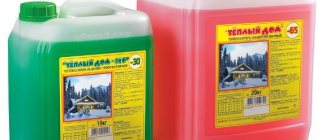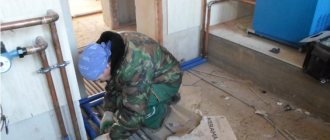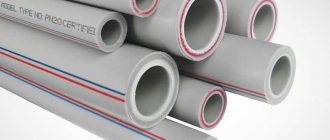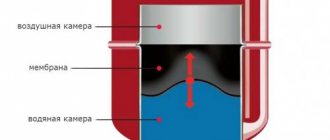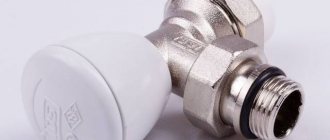As domestic construction companies master frame technology, two-story cottages are becoming more and more affordable.
Today, such a house, very warm and cozy (if you believe the advertising brochures), can be afforded even by a person with average income. N
No matter how warm the home is, you will have to solve the issue of heating it, unless it is a hut somewhere in the hot tropics.
Let's see what the heating system diagram for a two-story private house could be like and how to choose the most suitable one among the many options.
Heating project for a two-story house
Competent design of an effective heating system begins with determining the desired temperature regime for each room of a country house.
The most comfortable conditions (22 – 24 degrees) support:
- in children's rooms and rooms for the elderly;
- in the bathroom and toilet;
- in the sauna, gym or swimming pool.
For the following group of premises, the standard temperature is set at 21 degrees:
- bedrooms and guest rooms;
- staff rooms;
- premises for rent.
In a residential area, the minimum permissible temperature is 18°C:
- living room;
- study;
- dining room.
In a kitchen, home workshop or winter garden, additional heating means are usually installed, while a stationary heating system is designed for 15 - 16 degrees.
In the passage area, which includes the hallway, garage or staircase, the minimum temperature is 12 degrees.
Typical heating and water supply scheme for a cottage
Next, a calculation of heat loss is performed, in which, in addition to the indicated temperatures, the following is taken into account:
- Thermal resistance of the materials from which the enclosing structures are made.
- The average temperature of the coldest month in the construction region, as well as for the entire heating season.
- Seasonal boiler operation coefficient (for the middle zone - 0.5, to the north - 0.7, to the south - 0.3).
The amount of heat loss through the building envelope is calculated using the formula:
W= A * dT * (1/R * S),
Where
- W – heat loss power;
- A – surface area of the enclosing structure;
- dT – difference between internal and external temperatures;
- R – thermal resistance of the material (when calculating a multilayer structure, these parameters for each layer must be summed up);
- S – thickness of the material layer.
Based on the calculated heat losses, radiators are selected for each room (their heat output should compensate for heat leaks with a margin of 20%) and a heat generator.
Advantages and disadvantages
The passing system has more advantages than disadvantages.
Advantages of a system with associated water movement:
- The entire heating system warms up evenly, from the initial to the last radiator. Each room will be equally warm.
- There is no need to use expensive equipment and complex balancing.
- Possibility of installing heat regulators.
- Installation of the associated heating system is possible with your own hands; no special skills are required.
- The system has a long service life.
- High reliability and rare breakdowns.
- The system can be installed under the floor.
- The scheme is applicable for two-story houses.
- The system can operate by gravity.
- Increased pipe consumption. Their length is longer than in traditional systems. Pipes require a large number of shut-off valves.
- The pipes have a larger cross-section compared to conventional schemes, which means they will cost more.
- With a complex configuration of premises, the use of the scheme becomes impossible due to restrictions on the contours (you cannot use right angles, different heights of pipes).
- If the house has a large area and several floors, such a system will cost a significant amount.
Heating diagram for a two-story house
The next step is to determine the method of laying the pipelines and connecting the batteries. We will outline heating projects for a private two-story house. There are two options here:
Vertical
A vertical section is run from the boiler to the attic, along the perimeter of which a distribution ring is laid. Then several risers are lowered from the ring, which penetrate all the rooms. Radiators are connected to them.
Two-pipe vertical heating system
In this way, radiators from different floors, located one above the other, are combined into a sequence. A return ring is also laid in the basement, where the cooled coolant from the batteries is drained.
Advantages:
- It is easiest to move the cooling coolant in the direction from top to bottom (well suited for systems with natural circulation).
- You can install as many risers as you like, so this scheme is suitable for houses with a large floor area.
- The vertical supply and return pipes do not need to be separated, so they can be hidden in one niche.
Disadvantages: radiators are connected to the risers with a side connection, which is why they work less efficiently.
Horizontal
In this case, radiators located on the same level (floor) are combined into a sequence.
Advantages:
- You won’t need a pouring ring (it’s not always possible to install one, since you need an insulated attic or technical floor).
- Radiators are connected using a through circuit.
Flaws:
- The supply and return pipes will have to be spaced apart (the first above the batteries, the second below), so a hidden installation will most likely not work.
- The natural circulation of the coolant is hampered.
Due to the need to maintain the slope of horizontal pipelines, the length of the circuit is limited, and, accordingly, the heated area.
Traditionally used heating schemes
Depending on the type of pipe laying route and the connection of pipes to heating devices, the following systems are distinguished:
- Single-pipe . The coolant circulates through one pipe without the use of pumps. On the main line, radiator batteries are connected in series; from the very last, the cooled medium (“return”) is returned to the boiler through a pipe. The system is simple to implement and economical due to the need for fewer pipes. But the parallel movement of flows leads to a gradual cooling of the water; as a result, the media arrives at the radiators located at the end of the series chain significantly cooled. This effect increases with increasing number of radiator sections. Therefore, in rooms located near the boiler it will be excessively hot, and in remote ones it will be cold. To increase heat transfer, the number of sections in the batteries is increased, different pipe diameters are installed, additional control valves are installed, and each radiator is equipped with bypasses.
- Two-pipe . Each radiator battery is connected in parallel to the direct supply of hot coolant and the “return” pipes. That is, each device is equipped with an individual return outlet. With the simultaneous discharge of cooled water into the common circuit, the coolant is returned to the boiler for heating. But at the same time, the heating of heating devices gradually decreases as they move away from the heat supply sources. The radiator, located first in the network, receives the hottest water and is the first to return the coolant to the “return” circuit, and the radiator located at the end receives the coolant last with a lower heating temperature and is also the last to return water to the return circuit. In practice, in the first device the circulation of hot water is the best, and in the last the worst. It is worth noting the increased price of such systems compared to single-pipe systems.
Both schemes are justified for small areas, but are ineffective for extended networks.
An improved two-pipe heating scheme is the Tichelman heating scheme. When choosing a specific system, the determining factors are the availability of financial capabilities and the ability to provide the heating system with equipment that has the optimal required characteristics.
Single-pipe heating: advantages and disadvantages
Even in a horizontal circuit, pipes can be laid hidden if you use a single-pipe radiator connection scheme. This is the simplest and cheapest option, in which the heating devices form a sequence.
At the same time, only one pipe is used to connect them, moreover, it can be laid at any level (compare with the two-pipe heating diagram of a two-story house, where the supply pipe must be higher than the radiators).
One-pipe and two-pipe wiring
Taking advantage of this opportunity, homeowners often hide heating pipes in the floor structure, as a result of which the interior of the room retains its “pristine” appearance. And if you also install stylish tubular radiators, the design of the room will delight your guests.
However, the single-pipe heating system for a two-story house also has significant disadvantages:
- The coolant arrives at the last batteries of the circuit quite cool. Since gases dissolve in it better when water is cooled, self-airing often occurs in such a system. As a result, air drainage has to be installed on each radiator.
- There is no possibility of independently adjusting the heat transfer power on each device.
- If one of the radiators is repaired, the entire system has to be turned off and drained.
The disadvantages described in points "b" and "c" can be eliminated by connecting the input and output of each battery with a bypass jumper to the control valve.
Incidental heating scheme - device, application, how to do it
The associated heating pipeline wiring diagram is distinguished by the fact that it is self-regulating. If it is assembled correctly, then there is no need to adjust it after installation. Each radiator in this system must have the same pressure difference between supply and return. Each heating device in a parallel circuit operates under the same hydraulic conditions.
How does a ride work?
The same pressure difference on the radiators occurs because the sum of the supply and return lengths is the same for each. This can be clearly seen in the diagram. Take any battery from the system and estimate the total length of the supply and discharge pipelines to the boiler.
Those. all heating devices are in the same conditions automatically, and this is exactly what other schemes achieve through fine tuning and sometimes cannot achieve. For example, a beam circuit has a complex setup, where each battery is connected by a long pair of pipelines to one collector. The lengths of these pipelines are different, the radiators mutually influence each other, so the system must be carefully adjusted.
Pipe diameters
It is desirable that the diameter of the main pipeline (both supply and return) be the same throughout the entire ring, with the exception of connecting the last radiator. Where from the point of branching to the penultimate one, you can use a smaller diameter, because this will no longer be a main line, but a branch to the last heating device in the circuit. Those. the final section of both feed and return may have a smaller diameter.
Maintaining one significant diameter of the lines is necessary to ensure the same conditions for the radiators. Those. so that this “ride” would be a balanced system, where all batteries work stably under the same conditions.
If you start to “play” with savings and reduce the diameter of the line as the liquid moves (after all, less is required with each branch), then it is very easy to do, so that the group of last radiators will always be colder, i.e. The system will be difficult to configure.
Thus, for a small house with 6 - 8 radiators, a pipeline with a diameter of 26 mm is laid from the boiler (external for metal-plastic, for polypropylene and other materials - other values), then to the penultimate device - 16 mm. On the contrary, for the return line - from the first battery 16 mm, then from the second - a 26 mm ring to the boiler.
But this is just an example for a small system, and if the house is large, then the diameter of the pipelines may need to be larger, so that the pipeline does not make noise at the end sections, so that the speed in it does not exceed 0.7 m/s. The required diameter can be determined by a simple selection based on the connected power; an example of the calculation can also be found on this resource.
Do you always need a ride?
The associated heating system is more expensive than a dead-end heating system, by 20 percent. The cost overrun is associated with the use of large-diameter pipes, and especially their fittings - tees on the radiator branches and adapters to a smaller diameter to which the radiators are connected.
In a dead-end circuit, the diameters of the pipes will be smaller, since all the power is divided into 2 or more arms at the exit from the boiler.
Hiking becomes especially cumbersome when it is not possible to run pipes in a ring around the perimeter of the house - from the boiler outlet to its inlet. Then the return line has to be returned in the same way as the supply line.
The result is a complex loop of three main pipelines of great thickness. This should be avoided and the ride should be converted into a simpler dead-end scheme according to specific circumstances.
The usual transition to a dead-end system occurs when the number of radiators is reduced to 10 or less. Then it becomes possible to balance the radiators at dead ends and the shoulders themselves without significantly increasing the pump power.
With 3, 4 or even 5 radiators in an arm, there is no problem balancing all the radiators and arms in a dead-end heating circuit.
The practical magic of the Tichelman scheme
It is generally accepted that in a two-pipe heating system, the heat distribution between radiators due to the parallel connection is absolutely even.
This is not entirely true. First of all, let's understand that the hydraulic resistance of a pipeline is proportional to its length.
In a conventional two-pipe system, the path through the first radiator is the shortest for the coolant, and through the last - the longest.
Accordingly, in the first case, the medium has to overcome the minimum hydraulic resistance, and in the second - the maximum. It is clear that the liquid flows, figuratively speaking, more readily through the radiators closest to the boiler than through those further away.
To balance the system, it is proposed to start the “return” from the outlet pipe of the first radiator, then route it to the last, simultaneously connecting other radiators. And only after the connection from the last radiator is the return line directed to the boiler. This is Tichelman's scheme.
Thus, moving through any radiator, the coolant will travel a path of the same length with equal hydraulic resistance. In this case, the volumes of medium flowing through each device, as well as heat transfer, will become equal.
Heating a two-story house can be realized by using different systems: single-pipe, two-pipe, horizontal or vertical. A do-it-yourself heating diagram for a 2-story private house will help you do all the installation work correctly.
What kind of heating system is called Leningradka, you will find out here.
And in this topic https://microklimat.pro/sistemy-otopleniya/montazh-sistem-otopleniya/chastnyx-domov-svoimi-rukami.html we will consider do-it-yourself heating systems for private houses: water, steam, collector and other options. Overview of each heating type.
Types of two-pipe systems of a two-story house
Before choosing one or another option for a two-pipe heating system for a two-story house, the pipe layout and the type of circulation, you need to find out what they can be.
Firstly, depending on the spatial location of the inlet and outlet lines, a two-pipe system, just like a one-pipe system, can be made according to two schemes:
- With horizontal wiring - when the main pipes on each floor form separate conditionally horizontal (observing the required slopes) contours or loops;
- Vertical - when heated coolant is supplied to radiators at different levels and cooled water is removed from them using vertical risers.
Schemes with horizontal wiring can also be divided into:
- Simple - with serial connection of radiators to the supply pipe and the return pipe;
- Beam or collector - when each radiator is connected separately using two pipes to a special distributor (comb, collector). It can be separate for each floor, located in a niche or cabinet, or it can be common for the entire house, located in the boiler room.
Schemes with serial connection of radiators can be either with lower or upper distribution of the supply pipe. Collector or radial schemes, as a rule, involve lower pipe routing, and, very often, they are laid hidden, under the floor.
In addition, the schemes of two-pipe heating systems for two-story houses may differ in the way the coolant is circulated. Such circulation can be:
- Gravity or natural - when it is provided only by the difference in the specific gravity of the hot and cold coolant and the presence of slopes of the main pipelines;
- Forced - when a special circulation pump (or pumps) is used for this;
- Combined - when the system has the ability to work according to both schemes, depending on the circumstances.
Depending on the type of expansion tank and the method of creating excess pressure in the system, it can be:
- Open - when an open expansion tank is used, usually located under the ceiling on the second floor or in the attic, and the pressure in the system is determined only by the height of its placement. Often such a tank is also used as a central air collector (as in Fig. 1). This is possible if it is connected to the highest point of the supply pipe. If it is connected to the return pipe (for example, when installing a circulation pump on the “return”), then it is additionally necessary to install an air collector or air valve on the supply pipe;
- Closed - when a sealed membrane tank is used as an expansion tank. The excess pressure in such systems is calculated and is usually at 1.5 bar (0.15 MPa). Such a tank can be located anywhere on the supply or return line, but most often it is located near the boiler. A mandatory attribute of a closed system is the presence of a so-called “safety unit”, which includes safety and air valves and a pressure gauge, since there is a need to control excess fluid pressure and automatically release it if it increases above a set safe level.
An example of a closed heating system for a two-story house
The positive point is that in closed systems the access of air to the coolant during operation is closed, which reduces the corrosion of their elements, especially those made of “black” steel.
Having become familiar with the main types and features of two-pipe heating systems, we will consider some of the most common schemes that can be used for a private two-story house.
Open and closed systems
In open systems, the simplest container that communicates with the atmosphere is used as an expansion tank. It is installed at the highest point of the circuit, so it simultaneously plays the role of an air vent. Advantages of this scheme:
- cheapness;
- simplicity of design.
Flaws:
- Significant heat loss.
- The coolant evaporates (you have to constantly add it).
- Air dissolves in the working environment, so the system often has to be ventilated, and pipe corrosion occurs more intensely.
- With an excess pressure of at least 1 atm (when using a circulation pump), the open tank would have to be raised to a height of 10 m.
Expansion tank for closed heating
A closed system uses a sealed tank with a rubber membrane, which is supported by compressed air. Such a tank can be installed wherever it is convenient. But at the highest point of the system you will have to install an automatic air vent.
According to the list of advantages and disadvantages, a closed system is the opposite of an open one: it is more expensive and more difficult to install, but it does not require any maintenance and can work with any circulation pump. You just need to monitor the compressed air pressure and, if necessary, pump it up with a pump.
The organization of heating requires special attention, because the energy efficiency of the entire system depends on proper installation. Let's look at the connection diagrams for heating radiators and recommendations for choosing their installation location.
SNIP requirements for a boiler room in a private house are set out in this material.
Heating system and its types
The water heating system has become very popular, which is actively used not only in private houses, but also in apartments. The principle of such a system is that the coolant is water, which is transported from the boiler to the radiators. Radiators release heat into the room, after which the cooled water again flows to the boiler for heating.
There are 5 types of heating schemes that can be used when installing the heating system of a two-story private house. These types include:
- Gravity or natural circulation
- Single pipe system
- Two-pipe
- Collector or beam
- Underfloor heating system
All types of heating methods can be combined with each other, which will allow you to build the most efficient scheme. To learn about the characteristics of each type, you need to analyze them.
Collector circuit, versatility of application
The collector is a container with outlets through which the coolant flows to each radiator through an individual pipeline. Control valves are installed on the bends, and after them - pressure gauges.
This heating scheme for a two-story house provides the following advantages:
- On the spot, the homeowner can adjust the heat output of any radiator.
- Any section of the network can be isolated for maintenance and repair.
- When using a special type of collector - a hydraulic arrow - coolant with different temperatures can be supplied to individual radiators or circuits (used mainly for “warm floors”).
- As in a single-pipe system, the pipes can be laid in any way, including in the floor structure.
Collector heating system of a 2-story house
The disadvantages of this scheme are also very significant:
- Much more pipes will be required than for a conventional two-pipe system. Accordingly, installation will cost more.
- When laid open, a large number of pipes noticeably spoil the interior.
Again, due to the large length of the pipelines, the hydraulic resistance of the system increases significantly, so it cannot operate in natural circulation mode - a circulation pump is required. A separate pump will be needed for each circuit connected to the hydraulic arrow. If there is a power outage, of course, the system will be completely inoperable.
Characteristics and features of the system
The heating system with the associated movement of coolant was designed in 1901 by engineer Tichelman. In such a system, the liquid moves in the same direction along both circuits: supply and return. The length of the pipes along the contours is the same, the hydraulic conditions are similar. Therefore, the last heating device heats up just as well as the first. This system allows you to heat all rooms evenly and save fuel. The associated heating system has an alternative name - the “Tichelman loop”, in honor of its creator. Installation of such a system is recommended for heating large rooms with 10 or more radiators. In small houses, the use of such a system is advisable.
To install a passing system, a circulation pump is usually needed. A gravity-flow system is possible with a relatively small number of heating devices (no more than 10) and a one-story wiring.
What should you consider when choosing heating wiring diagrams in a two-story house?
When choosing a heating scheme, the homeowner is forced to balance between its functionality and ease of use, on the one hand, and cost, on the other.
The “golden mean” can confidently be considered a two-pipe system.
However, it is impossible to say unequivocally that in any case it will be better than a single-pipe one - a lot depends on the type of house and the location of the premises in it.
If the floor area is not large in size, and the rooms are arranged in descending order of comfort (for example, children's room - bedroom - living room - kitchen), then a single-pipe system will be more appropriate.
As for the collector system, due to the significant costs of purchasing materials and installation, it can currently only be recommended in exceptional cases. An example of this is houses, some of which are rented out or where servants live in addition to the family. That is, where the homeowner has limited access to certain rooms, as a result of which he cannot directly regulate the heat transfer of the radiators installed there.
Forced circulation system
Here, the movement of coolant through the pipeline network occurs due to the operation of a circulation pump, which creates excess pressure in it. The introduction of a pumping device into the circuit made it possible to achieve the following advantages:
- reduction of pipe diameters. The fluid flow rate has increased, and now a smaller pipe cross-section can be used to ensure the required flow rate;
- increasing work efficiency. If the heating circuit with forced circulation is designed correctly, then high-temperature water will successfully reach both the nearest and the furthest radiators;
- pipes can be laid in the most convenient way, which plays a huge role in interior design matters. The lion's share of highways can be hidden using boxes or floor and wall structures;
- convenience and comfort during operation. The fact is that forced circulation makes it possible to implement any projects to automate the maintenance of the climate in the house;
- efficiency in energy consumption. The conclusion stems from the previous paragraph, since automation allows you to heat rooms according to a daily schedule at a time when there are people there;
- the system is easy to regulate.
Note. In two-story houses where the old natural circulation scheme is used, you can always install a pump. This modernization will make it possible to realize, if not all, then the main advantages of the pressure system.
Installing a circuit with artificial stimulation is labor-intensive, but relatively simple; it can be easily done with your own hands. Take, for example, a membrane-type expansion tank, which does not need to be placed in the attic, and even controls the water level, as with gravity flow. Its place is in the furnace room, near the boiler.
The most significant drawback of the scheme is its energy dependence. All you have to do is turn off the electricity to the two-story house, and after a while there is no heat in the rooms. Methods to eliminate the deficiency, although simple, are expensive: purchasing and using an electric generator or, at worst, an uninterruptible power supply unit.
As for the supposedly high cost of materials, we have already discussed this issue when talking about a single-pipe system. Although it should be noted that the cost depends on the number of control valves and automation equipment included in the heating project. In a budget version, assembling the circuit will cost little more than a single-pipe one.
Conclusion. The system is recommended for use in two-story houses of any type and configuration, since it is considered the best option taking into account the price-quality ratio.


